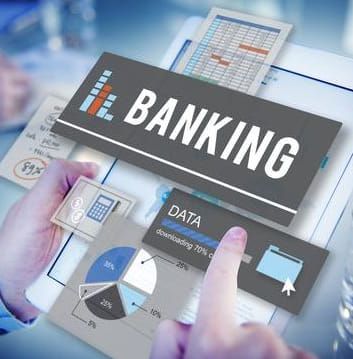The work of a modern bank cannot be imagined without progressive loans management software that allows the coordination of the activities of bank departments, expanding interbank relations, comprehensively solving the issues of analyzing banking activities, improving the technologies of banking operations, and increasing their level of manageability, in addition, helping to enhance the quality of service by creating automated jobs for professionals at all levels.
Technology is rapidly changing how banks operate and serve customers. Today’s consumers expect fast digital services, robust analytics, and omnichannel access. Meanwhile, banks face pressure to compete with financial technology companies that are unencumbered by legacy systems.

This had led to significant investment in banking software to:
- Upgrade outdated core systems
- Launch digital products to attract and retain consumers
- Leverage data analytics for risk management and hyper-personalization
- Integrate systems across channels for seamless experiences
- Automate manual processes to reduce costs
But with hundreds of vendors offering various point solutions, the banking software market can be complex to navigate. This blog provides an organized overview of the major categories and capabilities of banking software.
Whether you’re exploring options to overhaul core systems or add capabilities to support specific initiatives, this guide serves as an introduction to the key players and solutions shaping the future of banking technology.
Core Banking Systems
Core banking systems form the heart of a bank’s technology landscape. These back-end systems manage key functions such as deposits, loans, mortgages, payments, account opening, and customer service.
Mainframe Systems
Historically, banks relied on mainframe computers to run core systems. But maintaining complex, outdated mainframe infrastructure can be inefficient and expensive. As a result, many banks are modernizing through:
- Replatforming – Migrate systems to more modern, open computing architectures while retaining existing core system features. This provides long-term flexibility.
- Rip and replace – Fully replace legacy core systems with a new packaged solution. This can be costly and risky but allows banks to take advantage of modern features.
- Core transformation – Gradually transform systems by implementing new modules one by one over time. This reduces risk and disruption.
Packaged Core Systems

Many banks now opt for packaged core banking software from vendors like FIS, Fiserv, Temenos, and Finastra. These solutions are continually updated by vendors and can enable faster new product innovation.
Key capabilities include:
- Deposits & accounts
- Loans origination and maintenance
- Payments processing
- Customer data management
- Reporting and analytics
- Omnichannel banking
- Integration & APIs
The major downside is that customization options are limited. Switching core systems can also be extremely complex.
Digital Core Systems
A new breed of “digital core” systems from vendors like Thought Machine aims to leapfrog older platforms with cloud-native, flexible architecture optimized for digital experiences. They promise:
- Cloud deployment
- Microservices and APIs
- Real-time banking
- Rapid delivery of products
- Lower total cost of ownership
But longevity and market share for these newer solutions remain unproven compared to dominant legacy systems.
Lending Software
From underwriting to origination and servicing, purpose-built lending software is critical for managing credit products efficiently. Main types include:
Loan Origination Systems (LOS)
LOS software handles lending workflows from application to underwriting:
- Online applications
- Data collection and verification
- Credit risk models and decisioning
- Loan approval workflow
- Documentation management
Top vendors include Ellie Mae, Calyx, and Finastra.
Loan Management Systems
These systems help manage the lending lifecycle post-origination:
- Documentation
- Disbursements
- Accounting
- Customer service
- Portfolio analytics
- Regulatory reporting
Vendors include Shaw Systems, Nortridge, and iRise.
Mortgage LOS/LMS
Specialized mortgage lending systems handle unique needs like property appraisals, title insurance, and mortgage-specific regulations. Leaders include Ellie Mae, Black Knight, and Fiserv.
Payments Software
Payment systems enable banks to transmit and settle transactions across multiple networks and rails:
- Wire transfers
- ACH payments
- Debit/credit card processing
- Merchant services
- Cross-border remittance
- Real-time payments (RTP)
Major vendors include FIS, Fiserv, Mastercard, Visa, and ACI Worldwide.
Key capabilities:
- Payment gateways
- Transaction monitoring
- Fraud prevention
- Message conversion
- Communications protocols
- Rules engines
- Settlement and reconciliation
Top retail payments software includes Galaxy, PRESTIGE, and VisionPLUS.
Customer Relationship Management (CRM) Software
CRM systems capture and manage all customer interactions to enable personalization:
- Contact management
- Product tracking
- Service and complaint management
- Marketing automation
- Analytics and reporting
Leading banking CRM solutions include Salesforce Financial Services Cloud, Backbase Engagement Banking, and Enablement’s Banker Engagement Platform.
Key features include:
- Omnichannel integration
- Client analytics and segmentation
- Campaign management
- Contact center capabilities
- Compliance controls like TCPA
Account Opening Software
Onboarding solutions expedite new account opening online or via mobile:
- Identity verification
- Data validation
- Documents E-signature
- Funding
- Account creation
Top vendors include Alkami, Malauzai, and Avoka. Capabilities include:
- eKYC and AML compliance
- Data prefill
- Multi-product support
- Workflow automation
This improves onboarding rates while reducing fraud and manual efforts.
Analytics and Business Intelligence
Modern analytics help banks in areas like:
- Customer insights
- Product performance
- Campaign measurement
- Risk monitoring
- Operational analytics
Leading solutions include SAS Banking Analytics, FICO Analytics, and IBM Cognos Analytics.
Typical capabilities:
- Data visualization
- Statistical modeling
- Predictive analytics
- Real-time data processing
- Data mining
- Open/self-service access
This supports data-driven decision making enterprise-wide.
Fraud Detection and Security
Fraud detection and anti-money laundering (AML) systems analyze transactions and customer behavior to identify threats:
- Real-time alerts
- Suspicious activity monitoring
- Transaction scoring/decisioning
- Watchlist checking
Top vendors include FICO Falcon, SAS, and NICE Actimize.
Other security software helps mitigate risks like:
- Core system access controls
- Multi-factor authentication
- End-point security
- perimeter defenses
- Infrastructure monitoring
Leading security platforms come from vendors like IBM QRadar, Splunk, and McAfee.
Challenger Banks: Turnkey Banking-as-a-Service
New “challenger” banks use banking-as-a-service (BaaS) platforms to launch without building technology from scratch. These turnkey solutions from vendors like Galileo, Synapse, and Bankable include:
- Core system integration
- Mobile app and web portal
- Payments processing
- Compliance capabilities
- Go-to-market acceleration
This allows rapid deployment of basic banking services white-labeled under a new brand. However, challenger banks sacrifice flexibility and control over technology.
Evaluating Banking Software
With broad solutions across banking functions, conducting due diligence is crucial when selecting vendors. Key considerations include:
Functional Fit
- How well does it address current and future needs?
- Does it support your tech strategy and architecture?
- Will it deliver the desired benefits?
Vendor Profile
- Industry experience and client base
- Financial stability
- Implementation partners and resources
- Infrastructure and security posture
Technology Architecture
- Cloud readiness
- API and integration capability
- Scalability and extensibility
- Cybersecurity features
Cost Analysis
- Upfront and recurring licensing fees
- Implementation and customization costs
- Ongoing support needs and pricing
- Potential cost savings
Conclusion
Banking software spans a diverse landscape of solutions for core processing, lending, payments, security, analytics, and more. As banks aim to innovate faster and provide seamless omnichannel service, applications and middleware must extend core systems rather than create data silos.
This requires a clear technology strategy aligned to business goals. Banks should evaluate solutions holistically based on total cost of ownership, ability to support current and emerging needs, and flexibility for future initiatives. Developing a modular, API-based architecture is key to avoiding vendor lock-in and inflexibility.
The ideal banking technology ecosystem combines packaged solutions from established vendors along with selective in-house development and integration of emerging fintech. With the right balance, banks can meet customer demands today while laying a foundation to compete tomorrow.
Frequently Asked Questions
What are the main types of core banking systems?
The three primary types of core banking systems are traditional mainframe systems, packaged off-the-shelf solutions from major vendors, and newer “digital core” systems designed specifically for the cloud. Mainframes offer customization but can be expensive to maintain, while packaged systems enable faster upgrades but limit customization. Digital cores promise flexibility and rapid innovation but lack longevity.
What features should a good loan origination system have?
A robust loan origination system should handle the full lending workflow from application to underwriting. Key features include online applications, data verification, risk analysis, documentation, decisioning workflows and loan approval, and regulatory compliance capabilities. Top systems also integrate with third-party data services.
How can banks improve customer experiences with the right technology?
CRM, engagement banking platforms, and account opening systems allow banks to personalize experiences across channels. Capabilities like digital account opening, marketing automation, and contact center management enable consistent omnichannel engagement. Analytics provides customer insights to further optimize products and services.
What technology considerations are most important when selecting banking software?
The top considerations when selecting systems are functional fit, vendor profile, technology architecture, and cost. You want solutions that meet current and future needs from proven vendors. Systems should support your IT strategy, integrate well, and provide flexibility. Cost encompasses upfront licensing, customization, maintenance, and staffing requirements.
How can banks balance third-party software against in-house development?
Banks can avoid vendor lock-in by using third-party systems for key functions while developing custom applications for competitive differentiation. Hybrid models allow banks to benefit from vendor-managed solutions while still building unique capabilities where needed. API-based integration enables banks to rapidly swap solutions if needed.
Disclosure: The articles, guides and reviews on BlowSEO covering topics like SEO, digital marketing, technology, business, finance, streaming sites, travel and more are created by experienced professionals, marketers, developers and finance experts. Our goal is to provide helpful, in-depth, and well-researched content to our readers. You can learn more about our writers and the process we follow to create quality content by visiting our About Us and Content Creation Methodology pages.
